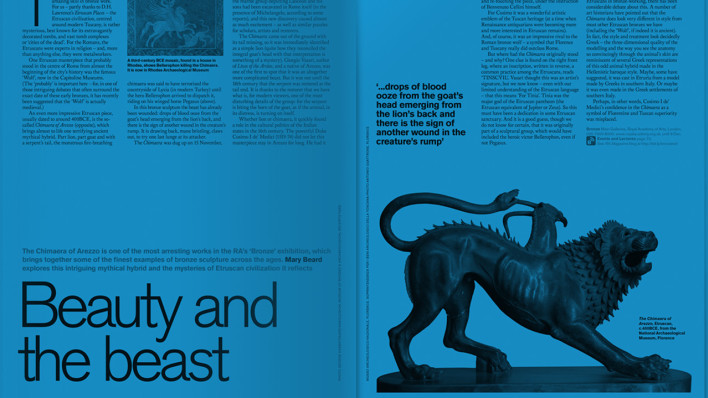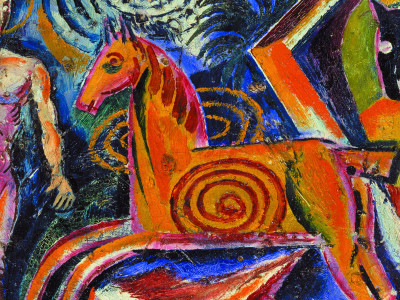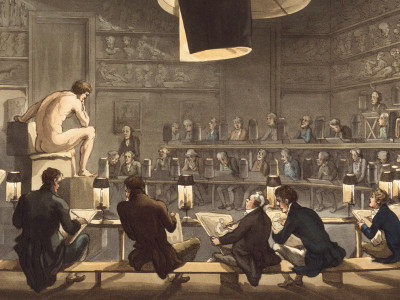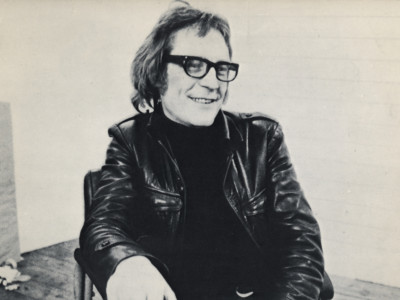
In the studio with Antony Gormley RA
By Fiona Maddocks
Published on 16 May 2010
Get the vital statistics on the Academician's studio, his work, and his relationship to the planet.
From the Summer 2010 issue of RA Magazine, issued quarterly to Friends of the RA.
"It’s good to be able to put down five tons of cast iron and know the building won’t collapse," grins Antony Gormley, waving a long arm in the general direction of the light, airy, warehouse-like space just north of King’s Cross, London, that is his studio. Bookshelves, plan chests and a couple of desk chairs hardly make an impact on the minimal elegance. "Really, it’s seven sheds next to each other in the manner of beach huts or factory roofs, each used for a different purpose workshop, office, plaster room, changing rooms, studio for Vicken (Parsons, his artist wife) and so on."
Gormley (b.1950, height 6ft 4in) lives and breathes vital statistics. Imperial, metric, quantum, continuum, no matter which. Within minutes he has reeled off the following: the total studio area is 10,000sq ft, which took him and his fellow RA, the architect David Chipperfield, 14 months to design, and nine months to build, using, among other materials, 200 tons of concrete. It can accommodate a 40-ton low-loader truck and is seven times the area of his old studio in Peckham, south London. This is now divided into a living space for three people including one of his three children, his architect daughter, Paloma, "so it’s being put to good use".
This last point is important for an artist who constantly asks awkward questions of himself and others about the relationship between art and the planet. "Yes, I use huge resources. Yes, I obviously believe in the work I do and I am fairly confident that it will still be here in the future, whether or not we are. Yes, I ask myself if this is a madman talking. Art is the most direct way in which human beings express themselves. If one had to make an account, I would rather art was saved than the defence industry. I see my work in the same tradition as a megalithic standing stone in the landscape, a construct of industrially produced mineral fossils that stand in time and space."
Spotting an area of London ripe for urban renewal long before the new St Pancras Eurostar terminal added continental glamour, Gormley has been here for seven years and is delighted by it all. He has 17 assistants, of whom four are full-time. Familiar examples of his sculpture are visible all around the double-height workshop, with delicate bubble-matrix clouds hanging from the rafters or upright figures, constructed from blocks, balls, steel wire, foam, fibreglass or cast iron, mysteriously inhabiting the shadowy recesses beyond.
His solo show at White Cube this summer, Breathing Room III, will consist of a "self-illuminating nest of 15 space frames" each identical in volume and together occupying one fifteenth of the total volume of the gallery. As so often in his work, the viewer can enter the space and in doing so becomes its subject.
When we meet, he is excited at the prospect of seeing his new permanent installation, Drift (2010) for Marina Bay Sands, Singapore, which "at 40m x 26m x 14m is the largest sculpture I’ve ever made… based on a polyhedral matrix consisting of 8,500 balls of stainless-steel".
These are the simple sums, the descriptive facts. Once Gormley, whose gargantuan sentence structures inhabit a verbal space every bit as generous as the work he creates, starts talking about matrix generation systems and Buckminster Fuller (inventor of the geodesic dome) I stop taking notes. "I can see you glazing over," he proffers. Not at all. But this aspect of his creativity is so brilliantly covered by the Oxford mathematician, Roger Penrose, in the catalogue of Gormley’s Aperture exhibition in Brussels last year, that it would be folly to compete.
His formal mode of discourse is a kind of a regime, which tallies with his serious, almost religious attitude to work: a privilege which requires dedication and application of the highest order to justify the pleasure he has in doing it. In part this can be explained by his upbringing. Born in London to a well-off Catholic family, he is the youngest of seven brothers and was brought up by the monks at Ampleforth College in North Yorkshire. Ritual, self-denial and restraint are instilled in him, even if God has long departed.
How else could he submit himself to the mental, if not physical, torture of providing his own body as the cast for much of his work. He is his own matrix, the geometer of himself. He walks, swims, bicycles and drinks green tea to keep fit for the purpose. The issue he addresses in every conceivable way is: "Where does the human body fit into the wider scheme of things?"
Event Horizon, which was seen on London’s rooftops in 2007, is now enjoying success in New York in and around Madison Square Park. Gormley speaks of it with amazement and emotion: "The scale and impact is so different in Manhattan because of the height of the skyline, so now the figures look like tiny whiskers, or whispers, on top of buildings like the Flatiron. They’re bodies on the edge, literally and metaphorically. Looking at them creates a dizzying sense of vertigo." Paraphrasing the philosopher Edmund Burke, he continues: "There’s no beauty without a sense of terror… But I’m glad to hear the New York Police Department has issued a statement to the effect that these are sculptures, not people thinking about suicide".
Prone to take life, as well as himself, seriously – though equally ready with a crinkle-eyed chuckle, which makes him engaging company – Gormley is preoccupied with our apocalyptic future: earthquakes and tsunamis, melting ice-caps and greenhouse gases. His response is to install solar panels, extra insulation and perhaps a wind turbine. "And if the sun has only five billion years left of nuclear energy…" He leaves the sentence unfinished, no doubt lost in hubble-bubble dreams of cosmic matrices, then lopes off energetically to return to the matter in hand.
Breathing Room III White Cube, Mason’s Yard, London, 3 June - 10 July 2010
Flare II St Paul’s Cathedral, London, until mid August 2010
Event Horizon Madison Square Park, New York, US, until 15 August 2010
Firmament IV Anna Schwartz Gallery, Sydney, Australia, until 3 July 2010
Antony Gormley by Martin Caiger-Smith (£14.99, Tate).
Fiona Maddocks is a journalist and broadcaster. She is Chief Music Critic of the Observer.

Enjoyed this article?
"As well as free entry to all of our exhibitions, Friends of the RA enjoy one of Britain’s most respected art magazines, delivered directly to your door.
Why not join the club?"
Related articles

Visions from Ukraine
19 June 2024

10 RA Schools stories through the centuries
16 May 2024

In memoriam: Mick Moon RA
1 May 2024